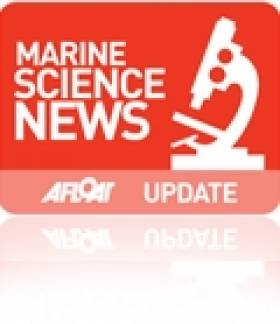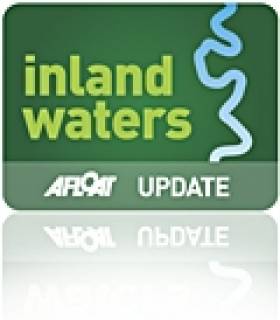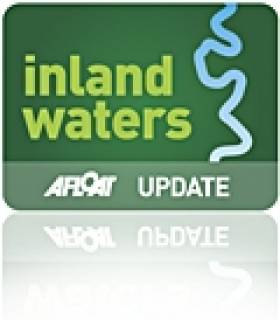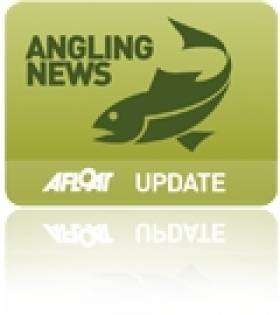Displaying items by tag: Something Fishy
Schools Essay Contest For Celtic Explorer Visit
#MarineScience - The Marine Institute invites fifth and sixth class primary school pupils to take part in Exploring the XTRA-Ordinary, a new writing competition where the winner and their class will be invited to visit Ireland’s national maritime research vessel Celtic Explorer in Galway in early December.
Students are asked to get creative and write a poem about the XTRA-Ordinary exploration on the RV Celtic Explorer and demonstrate their understanding of Ireland’s marine life and ocean.
The winner and their class will be given a tour on board the RV Celtic Explorer and get to meet the crew and scientists that work on board, as well as see the Remotely Operated Vehicle Holland 1.
Students will also get the opportunity to visit the Dry Lab, where scientists collect data from the ocean that is used to produce maps of Ireland’s seabed, and the Wet Lab where scientists collect marine samples and research marine species that live in the ocean.
A short-list of the entries will be displayed and winners will be announced at the 2013 Galway Science and Technology Festival that takes place at NUI Galway on 24 November from 10am to 6pm.
Entries must be sent to Cushla Dromgool-Regan, The RV Celtic Explorer’s XTRA-Ordinary Writing Competition, Communications Office, The Marine Institute, Rinville, Oranmore, Co Galway. The closing date for entries is Thursday 21 November 2013.
For more information about the competition see HERE. And teachers can find lesson plans about poetry, images and footage of marine species and habitats and the activities of the RV Celtic Explorer on the Marine Institute website HERE.
In other schools news, Ayr Hill National School in Ramelton, Co Donegal took the top honour in the 'Something Fishy' education programme for 2013.
Students and staff from the school visited the Donegal Education Centre on Friday 25 October to receive their national award – won in the last two years by schools in Co Wexford - for their class project on the River Leannan and the threat posed to it by invasive species.
At the award ceremony, Ayr Hill principal Hilary McNutt was presented with the perpetual trophy by Inland Fisheries Ireland chief Dr Ciaran Byrne and a class trophy from the IFI board chair Brendan O’Mahony.
Donegal GAA player Mark McHugh was also on hand to add his congratulations and present each student with an individual ‘goodie bag’.
McNutt praised the work of her pupils, the Education Centre and IFI staff Owen Kelly and Paul Burke, whose interest and passion for their work enthused and engaged the children with the project.
The River Leannan project involved preparatory class work and the pupils visiting eight sites along the river from source to sea taking physical readings as well as looking at land use, flora and fauna and in particular watching out for ‘alien species'.
Two in a Row for Wexford in 'Something Fishy' Schools Initiative
#INLAND WATERWAYS - Ballygarrett National School in Co Wexford fended off competition from 125 other primaries nationwide to win the 'Something Fishy' education programme for 2012.
The school claimed the award and a cheque for €500 for their project ‘Fishylympics’, a quirky blend of the Olympics, The X Factor and well known public figures,
and today receive their award and cheque for €500 from Minister Fergus O Dowd at Wexford Education Centre, Enniscorthy, Co. Wexford.
Presented on DVD, 'Fishylympics' is a dramatisation of the obstacles our native fish have to overcome to survive and win in the Fishylympics.
"I am convinced that wonderful learning experiences have been achieved and solid work produced on the basis of what I have seen, you have demonstrated imagination and an extensive level of understanding," said Minister Fergus O'Dowd, who presented the pupils with their prize at the Wexford Education Centre in Enniscorthy last Friday.
Four-time All-Ireland winner and Wexford camogie all-star Catherine O'Loughlin was also on hand to present each child with a goody bag.
She noted Wexford's two-in-a-row victory in the ‘Something Fishy’ competition – Donard National School took top place last year for their ecosystem-themed musical - and urged other schools in Wexford to take up the challenge set by Minister O'Dowd to go for a third.
Something Fishy is an educational resource originally designed and promoted by Inland Fisheries Ireland, in conjunction with the Blackrock Educational Centre, and is aimed at at fifth and sixth class pupils.
Originally based on the life cycle of salmon, it allows students to explore water, fish, fish stocks, angling, invasive species, conservation of rivers and lakes, and fish as part of the food chain.
Something Fishy now covers all fish species and invasive species. As well as class-based work, fisheries officers take students into the field to get hands-on experience of their work.
The competition has been run over the last seven years nationwide, and this year more than 120 schools took part, reaching over 5,000 individual students.
Nothing Fishy About Donard Pupils' Prizewinning Musical
Pupils at Donard National School fended off competition from across Ireland to win a coveted prize in the Inland Fisheries Ireland 'Something Fishy' competition for 2011, the New Ross Standard reports.
Wexford footballer Brian Malone presented fifth and sixth class pupils at Donard NS with goodie bags and an award for their entry 'Something Fishy - The Musical', which features songs and dances about the ecosystem of their local River Boro.
Dr Ciaran Byrne, IFI chief executive Dr Ciaran Byrne, who was on hand at the prizegiving ceremony at the Wexford Education Centre in Enniscorthy, commented on all entrants: “You guys are the caretakers of this environment and if you take this message with you today we will have a much better environment in 20 years’ time.”
More than 160 schools and 7,000 children took part this year in the 'Something Fishy' initiative, which is now in its sixth year of encouraging primary schoolchildren to explore different aspects of fish life.
The Irish Times has more on the story HERE.
Minister Lenihan Supports Environmental Initiative on Dublin's River Dodder
In preparation for the field trip Des Chew, Project Manager of the Dublin Angling Initiative visited the school and gave the pupils a talk on water quality, the lifecycle of trout and the art of fly-fishing. The pupils then participated in a field trip along the River Dodder, starting at Rathfarnham shopping centre and finishing at the confluence of the Dodder and Owendore rivers at Bushy Park. Minister Lenihan was joined by TV celebrity and angler Derek Davis.
Fisheries staff from Dublin Angling Initiative and Inland Fisheries Ireland took kick samples and were ably assisted by Gerry Heaslip and Brian McDonagh of the Dodder Angling Club. The children identified invertebrates and their delight could be heard far and wide as they found many different species of stonefly and caddis fly! Looking at water pollution indicators, the children could establish that the presence of these different types of invertebrates indicated the good water quality in the river. This is not surprising given the very healthy stock of wild brown trout in the river.
Minister Lenihan, remarked:
'It is wonderful today to see the young people out learning about their local river. The River Dodder is a very important river in south Dublin, it has good water quality, contains a healthy population of wild brown trout and is a wonderful angling resource.
This is in no small part due to the excellent relationship that the Dublin Angling Initiative and Inland Fisheries Ireland have with the Dodder Angling Club'.
Following this the children were given information packs on fish species, invertebrates and fish species posters. St. Pius X School has participated in Inland Fisheries Ireland's 'Something Fishy' programme in previous years and were thrilled to take part in such an exciting field trip of their local river.
The 'Something Fishy' project was developed by Inland Fisheries Ireland (formerly the Central and Regional Fisheries Boards) in association with Blackrock Education Centre and has proved a highly successful way of encouraging young people to take an interest in Irish fish species, their local environment and habitat. In 2010 almost 1,000 young people participated in the Something Fishy programme within the Eastern River Basin District.
































































